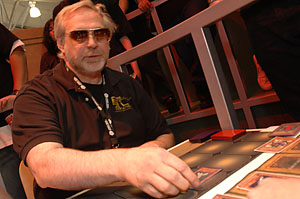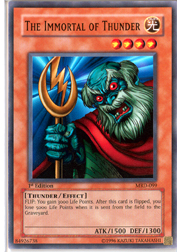We’re about four months into the current format, and we’ve got a pretty good idea of what to expect at Shonen Jump Championships now. Though the Monarch deck has been dominating, it’s by no means the only deck that can make the Top 8. We’ve seen many unique rogue decks and some soon-to-be cookie cutter decks sharing the spotlight with Monarchs for quite some time. However, Monarchs continue to take home the gold on Day 2. This provides an interesting twist on deckbuilding. Players must be prepared for the Monarch deck, but at the same time, they need to contend with the powerhouse builds that are going to increase in popularity.
Dark World is one such deck. It’s got some insane combo potential using high utility cards, meaning that it can function with or without drawing specific combos. Cyber-Stein has been wreaking havoc on conservative players or poor hands; there’s been a Top 8 finisher in every Shonen Jump Championship this format who’s relied primarily on Cyber-Stein to achieve victory. Warrior toolbox decks are also starting to emerge once again, including the formidable Royal Decree-based deck Fili Luna took to a second place finish at SJC Anaheim. With such a diverse metagame, it’s difficult to build a deck that can stand its ground throughout a nine or ten round tournament.
There is one bit of common ground between many of these decks. They all tend to rely on the contents of their graveyard in one way or another. Monarchs need their Treeborn Frog for the best success, and rely on graveyard effects such as Mystic Tomato, Sangan, and Magician of Faith. Dark World needs its graveyard to activate the effects of Goldd, Wu-Lord of Dark World and Sillva, Warlord of Dark World. Cyber-Stein-based decks aren’t as reliant, though they do have a handful of cards that can’t work without the graveyard. The same applies to the Warrior toolbox, which is usually supported by the Treeborn Frog/Monarch engine as well.
Kirk Leonhardt took notice of this and brought to Anaheim one of the most successful anti-metagame decks the game has seen in quite some time:
Monsters: 20
1 Mobius the Frost Monarch
2 Zaborg the Thunder Monarch
2 Cyber Dragon
3 D.D. Survivor
1 D. D. Assailant
1 Breaker the Magical Warrior
1 Bazoo the Soul-Eater
1 D. D. Warrior Lady
1 The Immortal of Thunder
3 Banisher of the Radiance
2 D.D. Scout Plane
1 Morphing Jar
1 Magician of Faith
Spells: 17
2 Big Bang Shot
1 Book of Moon
1 Creature Swap
3 Dimensional Fissure
2 Enemy Controller
2 Giant Trunade
1 Graceful Charity
1 Heavy Storm
1 Level Limit - Area B
1 Reinforcement of the Army
1 Scapegoat
1 Swords of Revealing Light
Traps: 5
1 Macro Cosmos
1 Mirror Force
1 Return from the Different Dimension
1 Ring of Destruction
1 Torrential Tribute
 Using the remove from play effects of Dimensional Fissure and Macro Cosmos allows Kirk to shut down the graveyard effects so many decks rely on. The rest of the deck is built around these two cards and the RFP idea.
Using the remove from play effects of Dimensional Fissure and Macro Cosmos allows Kirk to shut down the graveyard effects so many decks rely on. The rest of the deck is built around these two cards and the RFP idea.
Banisher of the Radiance is essentially a walking Macro Cosmos. Packing in 1600 ATK, Banisher is a great surprise card for Treeborn Frog and Mystic Tomato lovers everywhere. The best part about it is the opponent’s inability to tribute his or her monsters for Monarchs (who would be able to take down the Banisher) without first removing the offered tribute from play. This can often paralyze a Monarch opponent, who will wait with defensive cards, hoping your Banisher will attack and try to take out his or her monsters. But of course, Kirk’s got other plans . . .
This is where D.D. Survivor and D.D. Scout Plane come in. Under the protection of either Dimensional Fissure, Macro Cosmos, or Banisher of the Radiance, these monsters swing in freely the same way Sangan does. In fact, these monsters can often be better than Sangan, returning to the field to protect Kirk’s life points or set up for a tribute next turn. This puts the Monarch player in an instant lose-lose situation. One the one hand, the Monarch player can use a defensive card to protect his or her monster for another turn. However, if he or she doesn’t top deck a way to deal with the Banisher/Fissure/Cosmos, the defense is wasted, and the monster will be removed from play anyway. On the other hand, allowing his or her monster to be removed is certainly bad news, and now the Monarch player has defensive cards that will still be dead unless he or she top decks the same solutions. This kind of pressure is insanely difficult to deal with, and unless Kirk’s up against an extremely lucky opponent, all of his remove from play effects will be almost too much to overcome.
The deck contains three Monarchs despite having no Treeborn Frog or Brain Control/Soul Exchange. Kirk gets away with this by having D.D. Scout Plane and D.D. Survivor return to the field after being destroyed every turn a Banisher/Fissure/Cosmos is out. The effects of the Monarchs can deal with the live cards that the opponent is trying to play, leaving him or her with only the cards that are negated by the remove from play effects (and often sealing the game for Kirk).
Return from the Different Dimension is another great seal-the-deal type of card, which can pump out Kirk’s monsters that have been removed and didn’t instantly return to the field. Aside from its game-winning capability, Return can also bring back copies of D.D. Survivor that may have been removed from play in ways that didn’t trigger their effect, such as being discarded with Dimensional Fissure on the field or removed by Bazoo the Soul Eater. After being brought back through Return, the Survivor sticks around for good, since its effect triggers when it’s put back into the removed from play pile through Return from the Different Dimension’s second effect. Return can also revive the likes of D. D. Warrior Lady and D. D. Assailant, Banisher of the Radiance, or tribute fodder for a Monarch, making it an extremely versatile card for the deck.
 The Immortal of Thunder was a surprising card to see in the Top 8 of a Shonen Jump. However, after thinking it through, it makes an excellent anti-Stein card. If all goes according to plan, The Immortal of Thunder will never leave the field, or if it does, it will be removed from play: not destroyed. Doing so increases Kirk’s life points by 3000, often catapulting him out of Cyber-Stein range. If The Immortal can get some attacks in, it’ll spread the life points even further. With a face-down Macro Cosmos, Kirk can often bait players into wasting defensive cards on the Immortal, creating a one-for-one trade that increases his life by 3000. Not a bad deal at all. The Immortal is also incredible against rogue decks. Imagine Kirk against a burn deck, or a stall deck hoping to win off the effects of Wave-Motion Cannon or Cyber-Stein. The Immortal will often save Kirk from being OTK’d, and give him the extra turns he needs to win while the opponent attempts to draw answers. Consider the worst-case scenario, where Kirk either loses 2000 life points or has to summon the Immortal as a 1500 attacker. Not too shabby, and definitely worth the risk of the pay-offs.
The Immortal of Thunder was a surprising card to see in the Top 8 of a Shonen Jump. However, after thinking it through, it makes an excellent anti-Stein card. If all goes according to plan, The Immortal of Thunder will never leave the field, or if it does, it will be removed from play: not destroyed. Doing so increases Kirk’s life points by 3000, often catapulting him out of Cyber-Stein range. If The Immortal can get some attacks in, it’ll spread the life points even further. With a face-down Macro Cosmos, Kirk can often bait players into wasting defensive cards on the Immortal, creating a one-for-one trade that increases his life by 3000. Not a bad deal at all. The Immortal is also incredible against rogue decks. Imagine Kirk against a burn deck, or a stall deck hoping to win off the effects of Wave-Motion Cannon or Cyber-Stein. The Immortal will often save Kirk from being OTK’d, and give him the extra turns he needs to win while the opponent attempts to draw answers. Consider the worst-case scenario, where Kirk either loses 2000 life points or has to summon the Immortal as a 1500 attacker. Not too shabby, and definitely worth the risk of the pay-offs.
Big Bang Shot is a fun card for this deck. Pushing D.D. Survivor over Cyber Dragon and Cyber Dragon over Monarchs (while also doubling up as a great game-finishing card) is good enough to warrant playing it in this build. However, what makes it really shine is the ability to take opposing monsters out of play. In conjunction with Giant Trunade or Heavy Storm, Kirk could equip an opposing monster and remove it from play. Another nifty trick most people are unaware of is that, if you equip your opponent’s monster, he or she will still take the difference as battle damage to his or her life points. This can stall opposing attacks or blindside a player unaware of the ruling. Imagine playing Big Bang Shot on an opposing Monarch and setting a Banisher of the Radiance, then setting a back row card. Your opponent will suspect a piece of spell and trap removal waiting for his or her attack, and will attack anyway. Then, he or she will take the 2800 damage. While this is certainly a risky maneuver, it’s just one more in the bag of tricks Kirk had for Anaheim. (Jason’s Note: I actually witnessed Kirk briefing his opponents on this before Game 1 in at least one of his matches—what a good sport!)
Giant Trunade works in this deck perfectly as well. It combos up nicely with Big Bang Shot and Swords of Revealing Light, but it also can create game-winning scenarios for Kirk, who’ll often have more monsters than the opponent on the field. Protecting his Zaborgs or Banishers, even just for a turn, can mean the difference between winning and losing a duel.
This was clearly a well-thought-out deck, richly deserving its spot in the Top 8 of a Shonen Jump. While I still expect most players to continue side decking their Dimensional Fissure combos, it’s clear that anti-metagame decks can and do work if there’s enough thought put into them. Congratulations Kirk, for making an incredible build and proving to be one of the best builds the game has ever seen.